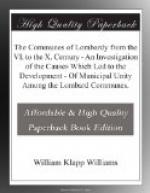It is not within the scope of this enquiry to trace the various steps or indicate the various influences, the civilizing effect of the Church, the restraining power of the law, by which this complete amalgamation of two distinct races became an accomplished fact; we need only to note that the unity of the race was achieved. Even Macchiavelli recognizes this fact and, speaking of the time of the Carlovingian conquest, in the brief review of the history of all Italy which forms the first part of the first book of the “Florentine History,” he truly says that, after two hundred and twenty-two years of occupation by the Lombards, “they retained nothing of the foreigner save the name."[10]
But we must always bear in mind that it was not a process of absorption of one race by another, but a process of combination, of amalgamation; a levelling process, by which some members of the conquered people, by natural and economic causes, were raised to the level of their superiors; and on the other hand, some of the conquerors, by reason of similar causes, fell to the rank of the subject population. By manumission and by the various forms of vassalage more or less honorable, and by gaining some economic importance by trade and other means, many of the descendants of the Roman population gained admission to the ranks of the Arimanni, and obtained the full franchise by the possession of landed property. By forfeitures, consequent poverty and ultimate pauperization, many of the Lombard stock lost their rank and their lands and entered the same state of vassalage with the great body of the people. We see evidences of this change, this levelling up and levelling down, all through the military code of Liutprand, and in the later one of Aistulf can even more distinctly trace its progress; and without entering into further detail, we can definitely state that, by the time we are now considering, all traces of distinct race-origin had disappeared in the mass of the people, and the only safe distinction that we can draw is to say that among the families of the dukes and greater nobles, the Lombard stock was preserved comparatively pure, and that the serf population was, generally speaking, of Roman descent.[11]
KING +--------------+--------------+ | | | COUNTS DUKES GASTALDS | +--------------+--------------+ | | | CUTANEI SCABINI SCULDAHIS (LATER BARONS) | | | | | | | | | +-------------------------------+ | | | +-------------------------+ | | | +-------------------+ | | | +-----------+ | | | | | | | | ARIMANNI | | | | MASNADA | | | ALDII | | SERFS | SLAVES
The above table, while its divisions must not be taken too literally, will, I think, give some indication of the estimation in which the various classes of society were held.




